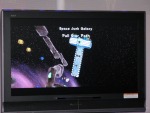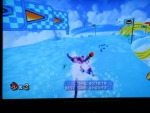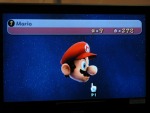Impressions
The game begins with a cinematic unlike any produced for a Mario title. The Mushroom Kingdom is celebrating the arrival of a hundred-year comet when Bowser attacks with a fleet of Doomships, complete with the music from Super Mario Bros. 3. Bowser's presentation is sinister, his fleet bombarding the Toad's celebration with balls of fire and ice. Mario runs to Peach, but he is too late. With a deep laugh, Bowser declares that he will be forming his own galaxy, with Peach at his side. A UFO appears over the Doomship fleet, slices out the land around Peach's castle, and lifts it into space. Mario manages to stay on the remnants of the quickly-rising castle bridge, but a laughing Magikoopa blasts him into space.
Mario awakes on a tiny planet where he must catch a trio of space rabbits. After being caught, the rabbits turn into star creatures and starry maiden known as Rosalina (previously called Rosetta in the Japanese version). She asks Mario to help her regain Power Stars to power her ship so that they can reach Peach.
Rosalina stands in the center of her space ship, the game's hub. The ship is divided into several platforms, and stages, known as "galaxies," are accessed from observatories located around the ship. Super Mario Galaxy had about a dozen levels available for play across several galaxies. Components of the three paths from the E3 2006 demo returned in various forms—some were separated into individual stages and stage bosses have been reorganized. Many of the stages have been seen before. The larger galaxies, such as the Good Egg Galaxy, had three stars to collect, while some only had one.
The Flipswitch Galaxy included a single tiny stage with one goal: change all of the ? tiles into ! tiles by walking over them. The tiles were arranged on three sides of a cube, and the tiles would switch when stepped on and switch again if stepped on a second time. Sliding spike blocks, an object emanating a radial laser beam, and enemies all try to impede Mario's path. The path Mario must take is a little tricky and jump timing is important since each tile must be walked over an odd number of times.
Galaxy takes the beautiful water effects from Sunshine and suspends them nonsensically in the form of the Loopdeloop Galaxy. This mini-galaxy involves a water skiing course much like the sliding or racing courses found in previous 3-D Mario platformers. This time, the game changes up controls here and steering is controlled by tilting the remote. Acceleration is handled by the A button, and the water dynamics actually make the course more difficult than it looks.
The Space Junk Galaxy was unique in that platforms floating in space flew into position by a mysterious force only when approaching them and would then fly back once sufficiently far away. The first major boss battle had Bowser Jr. enter on his Doomship and then direct Megaleg to attack Mario. Megaleg was the giant Bullet Bill-equipped robot seen in the original E3 demo. Upon defeat of the boss, Mario collected an apparently more important "Grand Star" rather than a regular Power Star.
The Bee Suit was the only power-up available in the E for All demo. Controlling somewhat like a refined FLUDD, the A button makes Mario hover for a limited time. He can also stick to honey on the side of honeycomb. One levels required Mario to fly onto a queen bee and recover star shards that cover her body.
Gravity is the major component of Super Mario Galaxy. While many planets are spherical, the spacescape has a number of oddly shaped objects. Objects with holes are an especially fun location to experiment with the game's gravity since it is possible to slingshot around several times. Due to the sphere/gravity design of the levels, the traditional bottomless pits have been replaced by black holes. That is, there are still plenty of places to fall to your doom—it's just no longer guaranteed what direction your doom can be found in.
One notable aspect of Galaxy is its camera control. Unlike the partially broken camera system of Sunshine, Galaxy's camera is fully automatic, and always seems to be positioned at the proper location. Control isn't always totally perfect since the camera changes dynamically, but it usually transitions smoothly enough for players to naturally adapt. In this way it seems Nintendo did all they could to insert hints of classic 2-D control into an inherently trickier 3-D environment.
Galaxy throws in some 2-D levels, seamlessly integrated into the 3-D environment. For instance, a pill-like capsule can be entered in one of the levels, and the camera switches to a side view. Color coded zones within the capsule indicate the direction of gravity, and Mario can jump between these zone types, landing upside-down from his initial orientation.
One nice feature is that the game has six save slots rather than the traditional three to four. Players choose from four Mario characters or any of their Miis to represent their file, replacing an empty file's barren moon. In a recent interview, Shigeru Miyamoto said that his team had to tone down the difficulty because the game was becoming too hard. The game seems set to deliver on the difficulty promise as I definitely saw a lot of "Too Bad!"s from people playing and dying during E for All. Unlike the original E3 demo, players now begin with only three hit points, though more can be collected later.
Super Mario Galaxy's amalgam of classic elements that made the Mario franchise so popular, new mechanics, and a stunning presentation leave the game with the potential to be the greatest Mario game ever, and certainly the greatest 3-D platformer.








